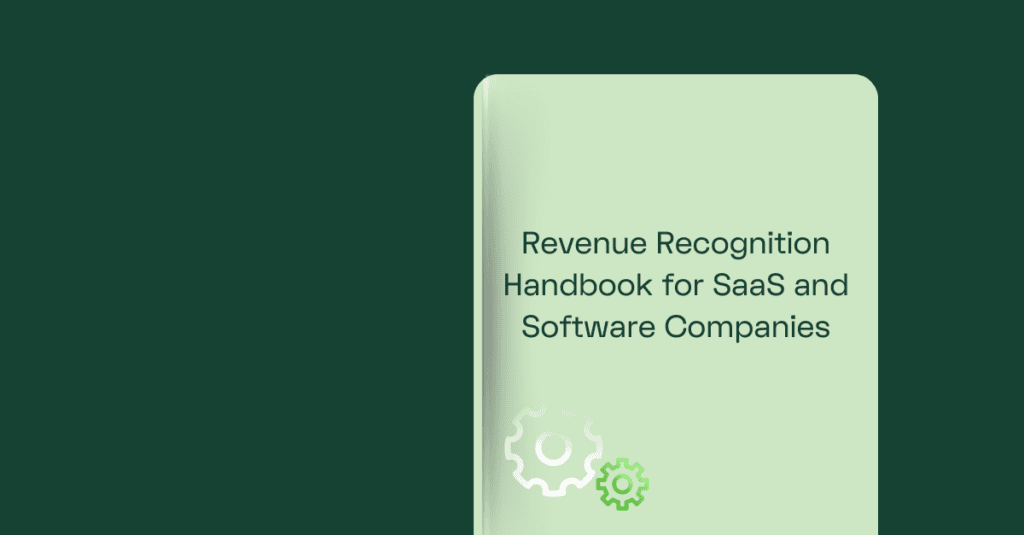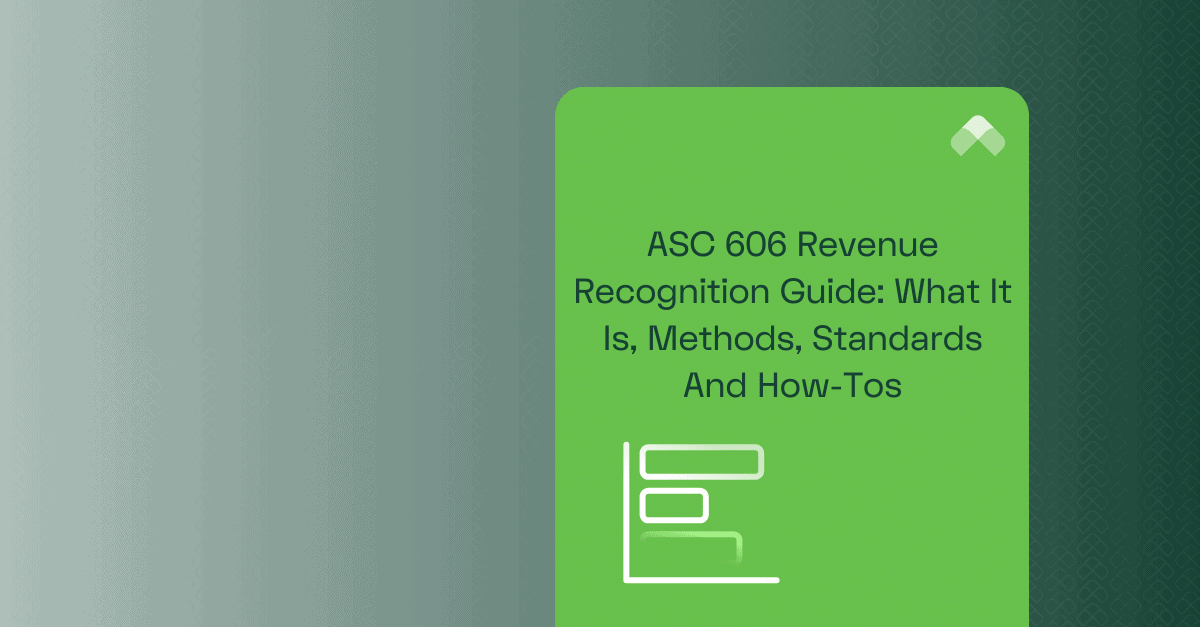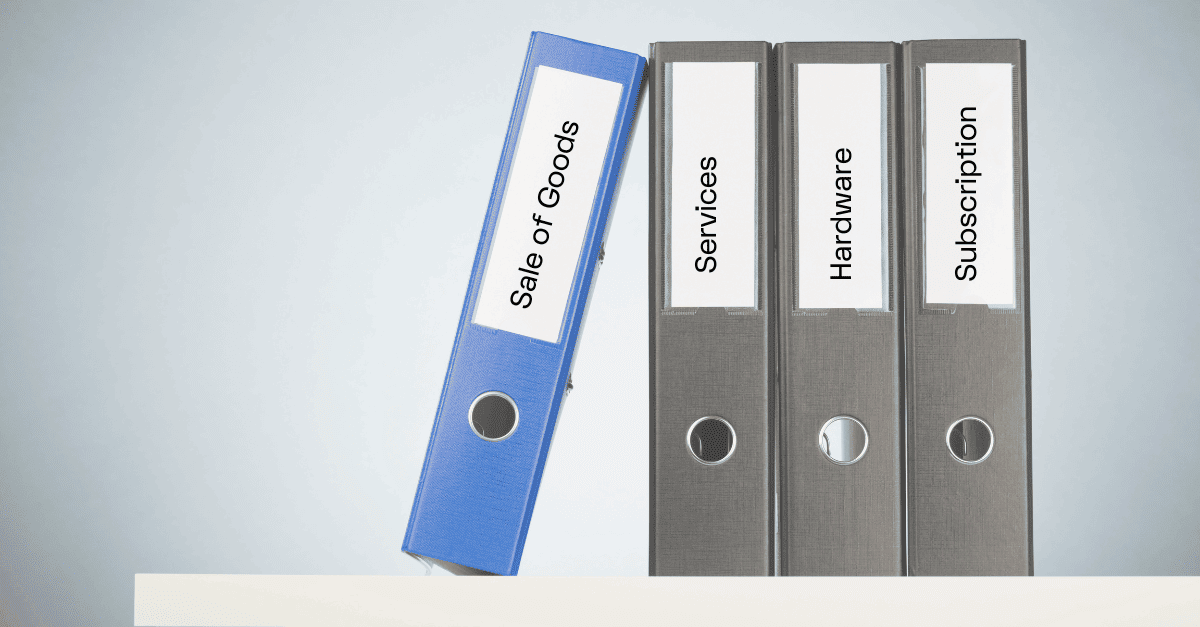Even seasoned accountants can sometimes feel overwhelmed or lost amid the challenges often accompanying revenue recognition. It’s a complex and tedious process with lots of moving parts. Thankfully, ASC 606 and its five-step framework are a guiding light, aiming to save accountants from the Wild Wild West of financial reporting requirements.
But even with the standardization that ASC 606 offers, it can get complex. So many questions need to be answered. Exactly when should we recognize the revenue? How should it be categorized? Did our salesperson offer a discount? How do we account for that?
The questions go on and on.
This article aims to go through several real-world ASC 606 revenue recognition examples to show how revenue should be recognized in each instance. We’ll cover multiple industries, from SaaS to telecommunications, and provide practical advice on tackling every step in the process. So let’s go ahead and jump right in!
What Is ASC 606 Revenue Recognition?
Issued by the Financial Accounting Standards Board (FASB), ASC 606 is a generally accepted accounting principle (GAAP) that specifies what businesses across all industries must do to report recognized revenue. Its primary aim is to standardize and enhance the consistency of revenue recognition practices, replacing a patchwork of industry-specific guidance.
According to ASC 606, companies must recognize revenue when their goods and services are delivered to customers. How, when, and how much is recognized is determined by the terms of delivery for the performance obligations (a contracted promise to provide a certain good or service). These terms can include activations, set-ups, consumption, and shipping goods and services that are met at a point in time or over the contract term.
ASC 606 requires companies to recognize revenue when goods or services are transferred to their customers in amounts that reflect the consideration they expect to receive, aligning revenue recognition with the transfer of control.
The broader implications of ASC 606 on financial transparency and comparability are substantial. Revenue recognition standards like ASC 606 promote greater transparency because companies must disclose detailed information and performance obligations in their financial statements. This makes it easier for investors, analysts, and stakeholders to make meaningful comparisons across different entities and industries, fostering confidence in financial reporting.
It’s absolutely crucial that CFOs and other accounting professionals develop a deep understanding of ASC 606 and its framework. Without this knowledge, they risk being out of ASC compliance.
Moreover, a solid grasp of these principles can facilitate informed decision-making around revenue recognition policies. The ASC 606 revenue recognition examples found later in this article should help bolster your understanding in this area.
Understanding the Five-Step Model for Revenue Recognition Under ASC 606
ASC 606 provides a standardized five-step framework for businesses to follow as they recognize revenue. Here are the steps briefly explaining each:
- Identify the contract with a customer. In other words, determine if a contract with identifiable rights and payment terms exists.
- Pinpoint the performance obligations in the contract. As a reminder, performance obligations refer to the distinct goods and services within a contract that the company has promised to transfer to the customer.
- Determine the transaction price. What’s the total amount of consideration (payment) the company expects to receive in exchange for fulfilling its performance obligations?
- Allocate the transaction price to the performance obligations. This allocation should be based on the standalone selling prices of the performance obligations.
- Recognize the revenue as performance obligations are satisfied. This occurs as the business transfers control of the promised goods or services to the customer, typically over time or at a point in time (although this part can get tricky).
By following this five-step model, businesses can ensure they are recognizing revenue in accordance with the guidance outlined by ASC 606. This can help them avoid losses and improve their financial stability over the long term.
When Is Revenue Recognized?
The above five-step ASC 606 framework is all well and good, but many financial professionals still question exactly when they should recognize revenue. Over time or at what specific point in time?
Let’s start with the idea that revenue recognition is essentially the determination of HOW and WHEN to recognize revenue on an income statement. The timing of revenue recognition, however, depends on the specific circumstances of the transaction.
Let’s run through several different scenarios.
Ratably (Over Time)
In this instance, revenue is recognized over time when the customer receives the benefits of the seller’s performance as it occurs. This method is typically used for services provided continuously over a period, like subscription services (subscription revenue recognition), long-term construction projects, or software licenses with ongoing updates and support.
Point-in-Time
Revenue is also sometimes recognized at a specific point in time when control of the goods or services transfers to the customer—in other words, when the product is delivered to the customer’s location or the service is completed like with a hardware product.
Upon Bookings
The phrase “upon bookings” typically refers to when a sale is booked. In other words, it’s the point in time when the sale is made and the sales agreements or contracts are signed.
Upon Billings
On the other hand, revenue can be recognized upon billings (when a customer is billed for the agreed-upon amount). In this case, the recognition of revenue occurs when the customer is invoiced.
Milestones, Delivery, or Other Events
Revenue recognition ultimately depends on the specific terms of the contract and when certain events occur, including milestones, deliverables, or other criteria agreed upon between the parties (e.g., upon the delivery of a good or service).
The key takeaway here is that revenue recognition in financial reporting should reflect the actual transfer of control, which may not always align with billing or booking dates. Accounting professionals must carefully consider the individual terms and conditions of each contract and recognize revenue based on the specific circumstances of each transaction.
Furthermore, it’s absolutely crucial that upstream sales teams and downstream accounting teams are tightly aligned when it comes to defining their contract terms and determining when control is transferred. Because, ultimately, it’s not just what you sell, but how you sell it that dictates how and when revenue should be accounted foraccounted. Sales and accounting teams must agree upon these factors.
Various ASC 606 Revenue Recognition Examples
Since so many factors can impact revenue recognition, it’s best to run through multiple examples for various industries. We’ll start by exploring how revenue recognition would work for a license-based software company that doesn’t offer cloud services.
Traditional Software Companies
Imagine a company that develops and sells license-based data analytics software. The software isn’t cloud-based but needs to be installed on the customer’s computer. Let’s apply the ASC 606 framework to understand how this company would recognize revenue for its software licenses.
Step 1: Identify the Contract With the Customer
The company sells its software to various businesses. Each software sale represents a contract with a customer.
Step 2: Identify the Performance Obligations
In this scenario, the software company has one primary performance obligation: Providing the software license to the customer. Additionally, it may offer maintenance and support services as separate performance obligations.
Step 3: Determine the Transaction Price
The transaction price is the amount the company expects to receive in exchange for transferring the software license. This may include the upfront license fee and any ongoing maintenance fees. The transaction price does not necessarily equate to the amount expected to be billed. Various factors such as fixed consideration, variable consideration (e.g., volume-based discounts and rebates), financing components, and other non-revenue items must be accounted for when determining a contract’s true transaction price.
Step 4: Allocate the Transaction Price
The company’s accounting team must allocate the transaction price (a portion to the software license and some to maintenance and support services) to each performance obligation based on their standalone selling prices. This must be done accurately to ensure the revenue is recognized appropriately.
Step 5: Recognize Revenue When or as the Performance Obligation Is Satisfied
Revenue is recognized when the customer receives the company’s software, typically during installation.
The company must be cautious not to recognize revenue before delivery of the product to the customer (at a point-in-time), even if payment is received upfront. Recognizing revenue too soon is a common pitfall that can lead to a mismatch between revenue recognition and the actual performance of the obligation.
If the company receives payment before satisfying its performance obligation (e.g., an upfront license fee), it should record the amount as deferred revenue on its balance sheet. Note that deferred revenue is not actual revenue but instead represents a liability. It will be recognized as revenue as the company satisfies its performance obligation at a point in time (in this example, upon customer acceptance of the software license(s)).
When it comes to maintenance or support services, this revenue should be recognized over time as the services are provided. The company should evenly spread this revenue over the service period. Even if the maintenance revenue is received annually, recognition should still be spread over the service period to match the performance obligation.
The company should clearly present its revenue recognition in its income statement and disclose any relevant information about how it applied ASC 606 in the footnotes of its financial statements.
SaaS Companies
In this example, let’s discuss a software-as-a-service (SaaS) company that offers multi-year contracts. It’s common to see two-year, three-year, and even five-year terms in this industry. Additionally, SaaS technology businesses often have to contend with varying contract modifications like upgrades, downgrades, and cancellations.
For example, XYZ Software signs a three-year contract with a customer for a software subscription at $36,000. The customer pays on an annual basis over the course of the contract term. After one year, the customer upgrades their subscription to a premium version, resulting in an additional $6,000 in revenue.
Step 1: Identify the Contract With the Customer
The contract with the customer is for a three-year software subscription.
Step 2: Identify the Performance Obligations
XYZ Software initially has one performance obligation—providing access to its software. The upgrade at the start of year 2 represents a second performance obligation being that a value is assigned to the upgrade and the upgrade is distinct from the initial software access and provides additional value to the customer.
Step 3: Determine the Transaction Price
Originally, the transaction price was $36,000 for the three-year contract. However, when the customer upgrades after one year, the additional $6,000 is added to the total contract value as a prospective modification, making the total transaction price $42,000 over the three-year term.
Step 4: Allocate the Transaction Price
The transaction price is allocated to each performance obligation. As the access to the software is identified as $36,000 over the 3-year term and the upgrade in year 2 is stated at $6,000, no additional allocation is required. The $36,000 is to be recognized ratably over the 3-year term, whereas the upgrade will only be recognized ratably over years 2 and 3.
Step 5: Recognize Revenue Over Time
Now ASC 606 really comes into play. Revenue, in this case, should be recognized over time as the customer receives and benefits from the software.
In this example, revenue is recognized ratably over the three-year contract term:
- Year 1: $36,000 / 3 years = $12,000
- Year 2: $36,000 / 3 years = $12,000 and $6,000 / 2 years = $3,000 ($15,000 total)
- Year 3: $36,000 / 3 years = $12,000 and $6,000 / 2 years = $3,000 ($15,000 total)
When the customer upgrades in year 2, the additional $6,000 is recognized ratably over the remaining term of the contract as the obligation to provide access to the premium version of the software continues through the end of the initial contract term.
One common mistake SaaS companies make is recognizing all the revenue upfront when a multi-year contract is signed. Note that an influx of cash isn’t the same as revenue since your customers could ask for it back until you deliver what you promised. Hence, ASC 606 requires revenue to be recognized when the customer receives the promised services, which typically occurs over the contract term.
Additionally, SaaS businesses must update their revenue whenever there are revenue-affecting contract modifications, like upgrades, so they stay compliant with ASC 606. This can be a real challenge for finance teams to stay up on. When done manually in spreadsheets, it’s a huge headache for revenue accountants.
Fortunately—businesses can now rely on revenue recognition services such as RightRev to automate this critical part of the process, eliminating the risk of any inadvertent oversights. If you’re interested in learning more about how automating revenue recognition works, we break it down for you.
Finally, companies should also account for downgrades and cancellations and adjust revenue recognition accordingly. If a customer downgrades, the SaaS revenue should reflect the reduced service.
In summary, SaaS companies with multi-year contracts must recognize revenue ratably over the contract term, even with contract modifications. In addition, they should properly identify performance obligations and adjust revenue for revenue-affecting changes or modifications to accurately recognize revenue.

To read more about revenue recognition for SaaS companies, check out our handbook!
Construction Companies
Businesses in the construction industry have their own unique revenue recognition complexities to tackle.
In this example, construction company ABC Builders Inc. specializes in building residential homes. The company enters into a contract with a customer to construct a new home. The contract specifies the construction timeline, payment terms, and any work scope variations.
Step 1: Identify the Contract With the Customer
The contract specifies that the total contract price is $500,000, and the project is expected to be completed in one year.
Step 2: Identify the Performance Obligations
The performance obligation in this contract is the construction of the home.
Step 3: Determine the Transaction Price
The transaction price is $500,000 (the total contract price).
Step 4: Allocate the Transaction Price
In this case, there’s only one performance obligation: The home’s construction. Therefore, the entire transaction price of $500,000 is allocated to this performance obligation.
Step 5: Recognize Revenue as Performance Obligations Are Satisfied
ABC Builders Inc. recognizes revenue as it satisfies its performance obligation over time. The company uses an input method, such as cost-to-cost, to measure progress towards completion. As costs are incurred in constructing the home, revenue is recognized proportionally.
It’s important to note that overbillings and underbillings often occur in construction contracts. These are due to differences between the amount billed to the customer and the revenue recognized as work progresses.
For example, suppose ABC Builders Inc. bills its customer more than the revenue recognized based on the project’s progress, In that case, it should record this as a liability—despite it being beneficial to cash flow. This overbilling represents a future performance obligation to the customer.
If, on the other hand, the builder bills its customer less than the revenue recognized based on the project’s progress, it should record this as an asset, representing its right to collect additional amounts from the customer in the future.
Builders must carefully account for over and underbillings or risk producing inaccurate financial reports.
Sometimes, construction companies recognize revenue too early, especially using the percentage-of-completion method. Revenue should only be recognized as performance obligations are met. Additionally, any contract modifications should be accounted for under ASC 606.
If the company is unsure about the collectibility of a payment, revenue recognition may need to be delayed. Finally, businesses must maintain proper documentation of progress, costs, and contract terms. Failure to do so can make it much harder to recognize revenue correctly.
Service Providers
Now, let’s dive into a brief asc 606 revenue recognition example that illustrates how a service provider can recognize revenue using three different methods: Point-in-time, completed milestones, and percentage of completion, along with common misconceptions or pitfalls that may arise.
Let’s say 123 Consulting is a service provider that offers project management services to its clients. Using…
Point-in-Time Revenue Recognition:
123 Consulting signed a contract with Client X to provide project management services for a fixed fee of $50,000. The project is expected to take three months to complete.
Per the company-defined revenue policy, the consulting company recognizes revenue of $50,000 once the project has been completed and handed over to Client X.
Some service providers may mistakenly recognize revenue once the contract is signed or the work begins. However, according to the Point-in-Time method, and as defined by the company’s revenue policy, revenue should only be recognized when the service has been fully provided and the client controls the outcome.
Milestone Revenue Recognition:
123 Consulting signed a contract with Client Y to manage a software development project with several phases. The contract outlines specific milestones for each phase, such as project planning, design, development, and testing.
The business recognizes revenue as the client approves each milestone. For example, once the design phase is completed and approved, revenue related to the design phase is recognized.
Service providers may be tempted to recognize revenue prematurely if they believe a milestone is met, even though the client hasn’t formally approved it. Proper documentation and client acceptance are crucial to avoid this situation.
Telecommunications Companies
Telecommunications businesses often charge their customers based on their usage of their service. How should ASC 606 be applied in this scenario? Let’s see…
456 Telecom provides mobile phone services to its customers. The company offers a usage-based billing plan where customers are billed based on the number of minutes they talk, the number of text messages they send, and the amount of data they use.
Step 1: Identify the Contract With the Customer
456 Telecom signs a contract with a customer for mobile phone services, specifying the terms and conditions, including the usage-based billing plan.
Step 2: Identify the Performance Obligations
The telecom identifies its performance obligations in the contract by carefully analyzing the terms and conditions of the agreement with the customer, including the services it’ll provide and any specific terms related to usage-based billing.
In this case, its promise of providing access to its mobile network is a distinct performance obligation.
If the contract includes bundled services (e.g., voice, text, and data services in one package), 456 Telecom must allocate a portion of the transaction price to each distinct service component based on their standalone selling prices. This ensures revenue is recognized appropriately for each component.
Step 3: Determine the Transaction Price
456 Telecom determines the total transaction price by estimating the variable consideration associated with usage. It considers historical usage patterns and sets prices per minute, per text message, and per gigabyte of data (the usage rating). The transaction price is the expected price, considering possible fluctuations in usage.
Step 4: Allocate the Transaction Price
The company allocates the transaction price to each performance obligation in the contract, including mobile network access, voice, and text usage.
Step 5: Recognize Revenue Over Time
456 Telecom’s finance team recognizes revenue according to how many minutes or how much data the customer uses. They use an output (e.g., minutes used) or input method (e.g., time elapsed) to measure the progress toward satisfying their performance obligations.
The company should continuously monitor customer usage and recognize revenue according to how much was used or consumed in the prior period. RightRev can recognize a zero-dollar revenue contract (since a contract exists, but usage amounts are zero until the usage amount has been measured and it’s rate has been applied) and apply revenue recognition rules based on a future-dated invoice.
How to Apply ASC 606 Principles
Below, we’ve listed several tips on best approaching the revenue recognition process:
- Set clear and comprehensive contract terms that spell out all obligations and commitments from all parties.
- Establish alignment between your sales and accounting teams on how the company’s products and services are sold and delivered to the customer.
- Make sure your accounting team keeps a watchful eye on every detail, as the devil is often in them. In fact, this is why automated revenue recognition systems like RightRev exist—to streamline the process so there’s less reliance on manual, error-prone processes.
- Determine when a customer pays versus when revenue is earned—this is particularly crucial for accrual accounting.
- When identifying performance obligations, look beyond the obvious to any implied promises or customer expectations.
- Carefully evaluate variable considerations and selling price concessions, aiming for a realistic reflection of what’s expected to land in your bank account when determining transaction prices.
Maintaining consistency and accuracy is paramount to avoid financial discrepancies and misguided decision-making. Remember, revenue recognition isn’t just about cash received; it’s about recognizing when your business has truly earned that revenue, and following these steps diligently will help achieve clarity.
It’s Hard to Achieve ASC 606 Compliance Without Help
As you can see with these examples, recognizing revenue can be an extremely intricate, complex, and confusing process at times—partly because every industry has to worry about different complexities, from contract modifications to over/under billings to service usage and more.
No matter how experienced and knowledgeable a finance team is about ASC 606, they will still come up against challenging scenarios and baffling questions. And there will be no avoiding all the spreadsheets and tedious manual data entry unless you automate the process, which ensures accuracy and compliance.
Automation in the ASC 606 Revenue Recognition Process (How RightRev Can Help)
With RightRev, automating your revenue recognition process is possible—saving your team unspeakable amounts of time and effort.
More than that, automation helps eliminate the errors that inevitably pop up when your accounting team is swamped in spreadsheet purgatory for hours upon hours. Plus, with RightRev, you can rest easy knowing that your company is 100% ASC 606 compliant.
Contact us today to learn how we can get rid of this headache for you!




